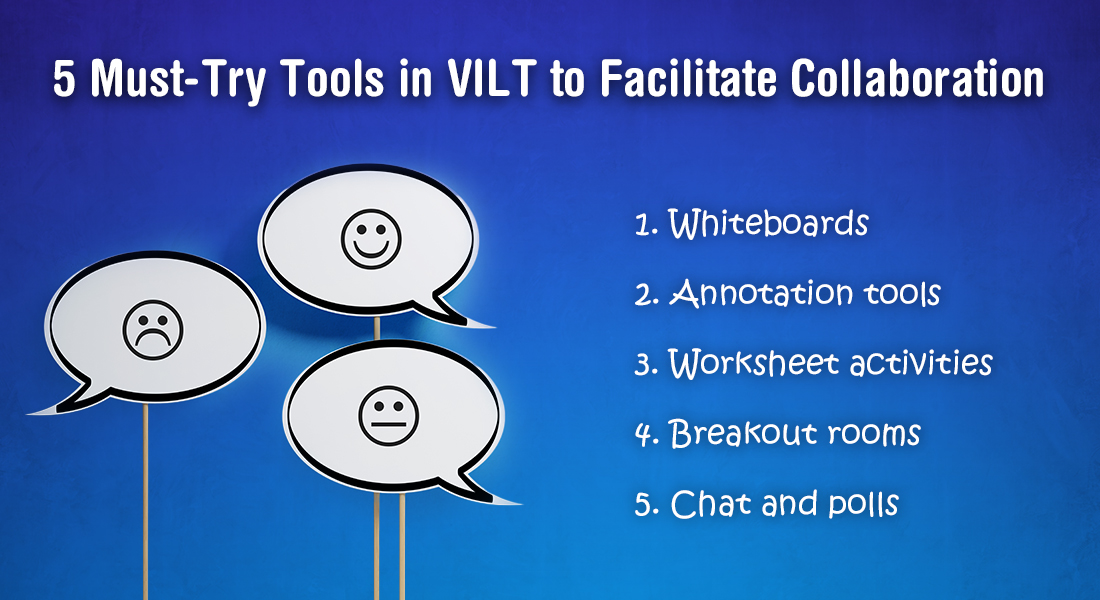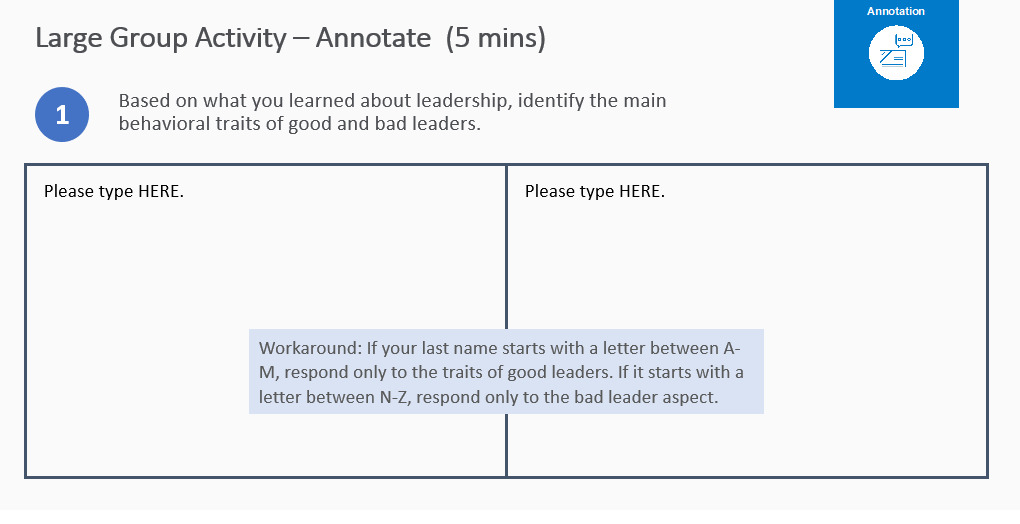How to Keep Learners from Daydreaming in VILT Sessions

What’s your biggest worry about shifting your in-person classroom training to virtual instructor-led training (VILT)?
Is it that your learners…
- Start flipping their smartphones during an on-going session?
- Daydream about a vacation they’re planning to take?
…………………………………………or (worst of all!) Doze off?
5 Must-try VILT Engagement Tools
- Whiteboard and annotation tools
- Worksheet activities
- Breakout rooms
- Chat and non-verbal feedback
- Polls
Well, these are likely scenarios if your VILT session is run on the lines of a webinar, with a lecture-styled approach offering few if any opportunities for interaction.
To prevent this from happening, you need to ensure your VILT sessions have ample scope for learners to interact with the content, the instructor, as well as with other learners. And how is that going to happen?
With a well-designed PPT presentation? Not enough!
An effective presentation is indeed the foundation for a good VILT session, but there’s so much more you can do with the virtual classroom platform to enliven the session. Let’s explore 5 features you can leverage to ensure learners sit through your VILT session, thoroughly engaged and motivated.
Explore how to master the art of designing and delivering impactful VILT in 60 minutes!
5 Tools for Interactive Learning in VILT
1. Whiteboard and Annotation Tools
Are you among those who think it’s okay to do away with introductions and ice breakers in VILT? Well, most organizations prefer that because of time constraints and the belief that ‘having fun while training’ is not necessary! However, we need to remember that in VILT, learners aren’t seeing each other (all the time), and most of them might still be figuring out how to use the virtual platform.
No, no, I am not saying you should let learners introduce themselves one at a time (by audio or the webcam). There isn’t enough time and most importantly, it’s boring! Instead, you can use the whiteboard and annotation features of the VILT platform – a much faster and engaging way to kick start any session.
Use the whiteboard (treat it like a slide) to create a grid for learners to claim their space. Ask them to use annotation tools (pen, pencil, text box, draw) to type in their names, roles, current location, or anything that is relevant to be shared. Let some of them also talk about what they shared.

Image: Microsoft Teams’ Whiteboard
In fact, you could also use the whiteboard and annotation tools for group activities in formal training. Here’s an example of how we used these tools during leadership training, where learners were asked to jot down the traits of good and bad leaders using annotation tools.

2. Worksheet Activities
Worksheet activities do work well for in-person classroom training activities, but will they work in the virtual classroom? Why not? Worksheet activities have been an all-time favorite when it comes to making learners brainstorm while they catch on some fun.
Worksheets activities can be on strategy and planning, team building, communication exercises, leadership exercises, and more. It’s always better to identify beforehand which worksheet activities you would want in the VILT platform.
Here are some tips to help you plan worksheet activities for the VILT session:
- Decide on the mode – hard or soft copy? If its hard copies, printouts will need to be taken before the session starts.
- Mail worksheets to learners at least one day before the actual session.
- Decide if you want learners to share snapshots of the worksheet activities for discussion. If yes, share the instructions in the facilitator’s guide and inform learners what they need to do.
- Decide where learners need to share the snapshots – in the VILT platform
(real-time) or the LMS it has been integrated with?
3. Breakout Rooms
Unlike a webinar, VILT is not a ‘one-to-all’ training approach! In fact, you can break the monotony and promote self-directed learning in VILT with breakout rooms (sub-rooms that can be created within the platform for collaborative learning activities). They actually allow you to think beyond the box or a ‘one-size-fits-all’ approach.
Since no two learners are the same, breakout rooms help cater to different learners’ styles and needs. While one group works on a problem on their own, the instructor can assist groups that need guidance. This keeps the former challenged and energized while others are catching up. It also reduces the risk of failure or falling behind for certain groups.
Here’s how breakout rooms can be leveraged in VILT to beat the boredom devil!
- Divide learners into groups to work on shared topics or competitive challenges. Groups working on tasks can be assured their ideas will not be overheard or observed by others.
- Assign different parts of the topic to different groups and ask each group to summarize their thoughts to everyone. This can make things faster and more engaging (for learners who take charge of their own learning) than the instructor running through a PPT.
- Let learners (in small groups) take turns to explain topics to one another and receive immediate feedback from fellow learners and the instructor. Instead of merely receiving information, learners will process, incorporate, and share it – making for a sticky learning experience.
4. Chat and Non-Verbal Feedback
Making learners to unmute and talk in the session is often the biggest challenge in any virtual meet-up. I’m sure you’ll agree with me on that!
Many learners do not like being called upon or even use ‘raise the hand’ option to ask questions. This often become a barrier to thoughtful, interesting, and collaborative discussions, leading to what we dread the most in virtual classrooms – lectures!
Here’s chat and non-verbal feedback options to the rescue!
Even though ‘chat’ seems like a simple option, it never fails to amaze how creatively it can be used. For instance, you can create slides with a simple image, text, or even one word, and set up a point of discussion for the class. Let learners respond to the slide using chat. The instructor can summarize what he read on the chat, without going too deep.
In addition, learners can be encouraged to use non-verbal communication cues, such as yes, no, go slow, go faster, need a break, clap etc. to give instant feedback to the instructor, helping him modify instruction.

Image: Zoom’s Non-verbal Feedback Cues
5. Polls
Undoubtedly the most-used tool in any virtual classroom session, polls are so dynamic that they can be used at different points for different purposes. But, most importantly, polls are quick, timesaving, and garner maximum learner engagement.
Polls can be used to:
- Find out learners’ current understanding before beginning a topic (with a single or multiple-choice question).
- Gather learners’ feedback and identify learning any issues in real time.
- Stimulate discussions with open-ended questions – such as, “What do you think is the USP of the new product?”
- Ask close-ended questions to ensure learners are retaining what’s being taught.
- Gather feedback on the overall session to make improvements in future sessions.
Here are some popular tools that you can use to jazz up the polls in your virtual classroom.
- Vevox
- Poll Everywhere
- Mentimeter
- VoxVote
Wrapping It Up!
Having doubts about VILT’s capability to engage learners is but natural. However, thanks to technological advances, VILT is no longer the conventional ‘broadcast’ style training approach. It offers tools and features that help replicate the real classroom, virtually! And with COVID-19, digital learning is certainly transforming the way people train their employees, making it all the more important for you to buck up and change with the times.
According to the State of Learning and Development in the Workplace Report by Valamis, “approximately 70% of executives value digital learning and development more as a result of COVID-19, and over 67% of all global survey respondents believe digital learning and development can help minimize the effects of shocks and stresses of future events.”
In such a scenario, do you really want to ignore virtual instructor-led training because of myths about its disengagement? Certainly not!
To help you understand VILT better, you should download this eBook – Virtual Instructor-led Training: A Beginner’s Guide – Explore the Art and Science of Replicating the Real Classroom Virtually.




![Top 3 VILT Platforms and Their Noteworthy Features [Explained]](https://blog.commlabindia.com/hubfs/Imported_Blog_Media/Top-3-VILT-Platforms-and-Their-Noteworthy-Features-Explained.jpg)
![How to Enhance Learner Engagement in a VILT Session? [Video]](https://blog.commlabindia.com/hubfs/Imported_Blog_Media/vilt-ways-enhance-learner-engagement-video.jpg)